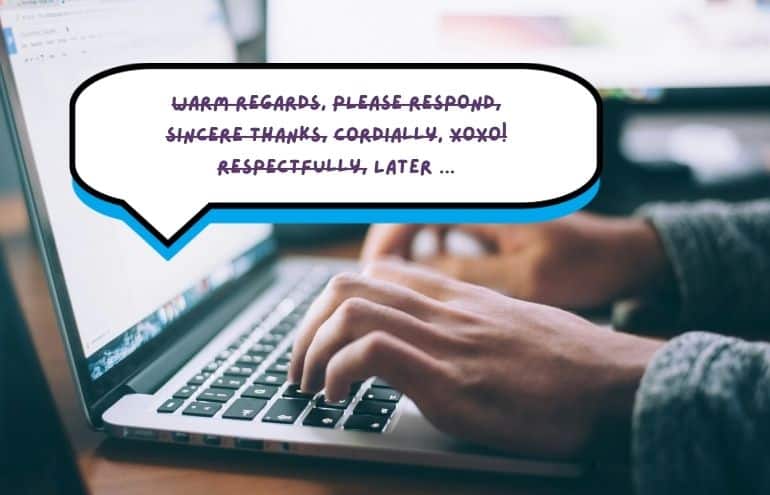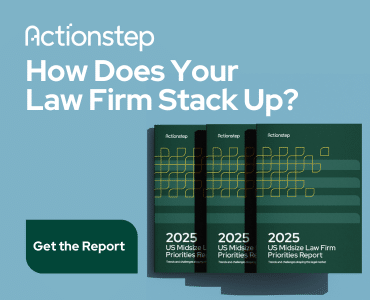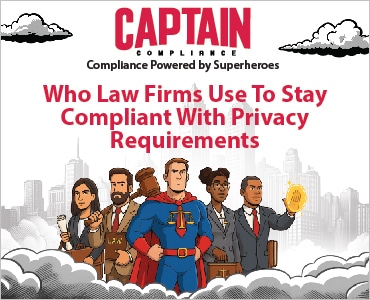What’s the best way to end an email? Learn the best email sign-offs for legal communicators in Bull Garlington’s definitive closing argument on the argument of closings.

Table of contents
- Signing Off: What’s the Best Way to End an Email?
- Every Emailer for Themselves
- With Kind Regards, What’s the Closing’s Job?
- Thank You for the Feedback! You Don’t Have to Get Weird to Be Unique
- Warmly, There’s Nothing Wrong with Changing Up Your Closing Game
- With Appreciation, the Most Common Closings are Common for a Reason
- With All Due Respect, Put Some Effort Into Your Email Sign-off
- Frequently Asked Questions About Signing Off
Signing Off: What’s the Best Way to End an Email?
Sincerely, ending an email is the second-hardest thing about writing one. Saying hello is the first. Worrying about either will drive you out of your tree. Trying to figure out how to sign off on emails will drive you the furthest because the wide, misty fields of blank after the last period are a lawless wasteland. There are opinions — even heated exchanges over whether “Best” is the sign-off most used by the worst best people — but no real rules. (Best, Margo. Sincerely. All. My. Best.)
Every Emailer for Themselves
Everyone has their signature email sign-off style. You inherited yours from your first real job. It came with 10,000 emails a day, and you’ve been using it ever since. It’s a workhorse, it’s served you well, and it is an obsequious cliché that makes you want to write something, anything, else.
Respectfully, you can’t.
Not that there’s a rule about this. It’s worse, there are NO rules about it. There are traditions, and traditions are impossible to change. Especially when the tradition is false. The idea that you have to use the same worn-out, lame, empty sign-off is, warmly, ridiculous. You can say anything you want …. OK. No, you can’t. You have to approximate professionalism, even if you’re secretly wearing Spider-Man pants below that Zoom frame. You’ve got a reputation, and you’d damn well better protect your reputation before you end up with a reputation.
Sincerely, you can’t go all willy-nilly at the end of an email, but you can crawl out of the customary. You can try something different. There’s a wee bit of marketing wisdom here, if you’re into personal branding or like to stand out. Your email signature can be as unique as your signature signature.
With Kind Regards, What’s the Closing’s Job?
To close the letter. Honestly, that’s it. You’re wrapping up a brief communique. The closing signifies to your reader that “this is the end of my thought.” “I’m stopping now.”
Somewhere in the history of hanging up, however, we also started noting our mood at the end of our missives. Some of the oldest sing-offs were elaborate and slightly louche. Look at how Stephen, Count of Blois and Chartres, closed a letter to his wife, written in 1098, during the First Crusade:
These which I write to you, are only a few things, dearest, of the many which we have done, and because I am not able to tell you, dearest, what is in my mind, I charge you to do right, to carefully watch over your land, to do your duty as you ought to your children and your vassals. You will certainly see me just as soon as I possibly return to you. Farewell.
Kind of personal, maybe a little overboard. Not as much as Leo Tolstoy who, in only three words, got sent to HR after closing with:
I kiss you.
Respectfully, the purpose of the closing is to wrap up your thoughts, reinforce tone and relate your mood.
Thank You for the Feedback! You Don’t Have to Get Weird to Be Unique
In fact, you don’t have to be unique to stand out. You could just use a closing from not too far back in fashion, like “Yours.” It is succinct, conveys a sense of service, and it’s almost impossible to misinterpret. Respectfully, however, it does nothing to communicate your mood, which is the second most important purpose of a sign-off.
It could be the mood you’re in because of whatever you’re writing about. If your manager, Todd, still hasn’t gotten the message about turning in his TPS reports, you’re within your rights to close with: PLEASE ADVISE, or “Attaching email thread for ease of reference,” which, like “per our last email” is diplomacy for READ THE EMAILS, TODD.
Warmly, There’s Nothing Wrong with Changing Up Your Closing Game
You know your niche better than anyone, so you know just how far from formal you can forage for a freaky finale. As a humorist, I can get away with pretty much anything. I’ve used “Worm regards,” “Struggling,” “Kidnapped by the Amish,” and my favorite, “Bigfoot is real.”
With Appreciation, the Most Common Closings are Common for a Reason

They work. They’re clear. They’re unambiguous. They can’t lug around any undertones. They are familiar enough that they’re nearly invisible, which is a good thing. Pick one of these email closings and stick with it:
- Thanks
- Warm regards
- Cordially
- Many thanks
- With respect
- Respectfully
- Best
Circling back, here are some more creative closings you could consider as starting points for developing your own:
- With Enthusiasm
- Later
- Seriously, Thanks
- Cold Regards
- Insert [platitude] here
With All Due Respect, Put Some Effort Into Your Email Sign-off
This is your last word. It’s the final thought. It’s your last opportunity to make an impression and sneak some marketing into your letter. Let’s say you had a long call with outside counsel, a small firm you really want to keep around. The attorney you worked with mentioned she’s headed to Tahiti for a well-deserved weekend in the sun. Try this: “Have a blast in Tahiti!” It’s so easy, yet it’s so personal. Like any gesture marketing, showing the tiniest extra effort can make all the difference in someone’s day.
Currently scowling,
Bull Garlington
Frequently Asked Questions About Signing Off
An email signature is a block of information embedded in your emails, like a footer. It typically contains your full name, organization name, contact information (phone number, email address), photo, company logo, and social media links. With all due respect, your closing or email sign-off is the final phrase you use to end your email, just before typing your name.
It depends. Just how angry/ happy/caffeinated are you? The exclamation mark is powerful, and once you begin using it, it’s a slippery slope. You’ll find it almost impossible to stop without offending or worrying your regular email recipients. (Instead of saying “Thanks!,” Jill said “Thanks,” today. Did something happen? Is she, you know, OK? Did I do something wrong?) Use exclamation marks with caution, unless cheerful is your brand (how dare you).
Everything is subject to state bar ethics rules.
👀 😂 🛑 💀 ✉️ 👋🏾 ⛔
Even for internal communications, a concise sign-off can be helpful for clarity and consistency. While coworkers might be comfortable with informal closings (like “Thanks,” “Cheers,” or no sign-off at all), ending your message courteously can help maintain a respectful tone and demonstrate professionalism within your team or organization.
Cultural norms can differ significantly when it comes to email etiquette. Research your recipient’s local business customs or consult colleagues who are familiar with the region. Generally, it’s safer to use more formal, neutral closings—like “Sincerely” or “Best regards”—when you’re unsure about the local practices.
If you want to stand out or inject personality, try sign-offs that match your role or industry—such as “Keep Innovating” (for a tech startup) or “Stay Creative” (for a design agency). Just be sure to gauge whether your audience is open to a less conventional closing, and always keep it respectful and relevant to your professional brand.

















